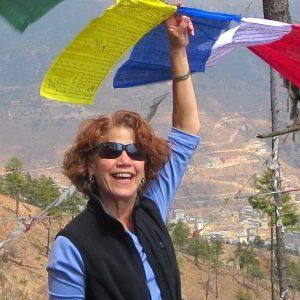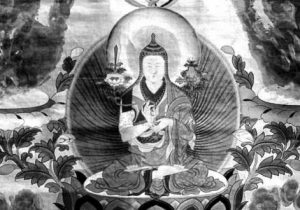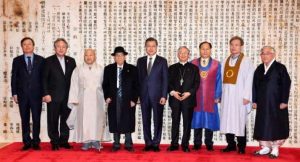
The nuns of Nagi Gompa, in their mountaintop abbey in Shivapuri Nagarjuna National Park on the outskirts of Kathmandu, are known for their chöd cham. Chöd, meaning “severance,” is a Vajrayana spiritual practice that engages prayer, visualization, singing, drumming, and bell ringing to cut through ego-clinging and dualistic thinking. The practice, formulated by the female Tibetan master and yogini Machig Labdrön (1055–1149), employs visualizing a vast banquet in which one offers one’s physical body as a feast to be consumed by numerous guests─including one’s demons, or most difficult obstacles. The process is a method for realizing “emptiness”─softening our tendency to grasp at a fixed and separate self-concept and all consequent subject-object dualism. This profound ritual is sometimes offered to heal the sick or to usher the deceased to a positive rebirth.

The chöd cham, or chöd ritual dance, is performed as a preliminary to prepare the space and oneself for the ensuing practice. Nonetheless, the nuns only perform it on special occasions─for Losar (the Tibetan New Year), at the completion of Yarne (Summer Rains retreat), and sometimes for other organized events.
Pa-pa, pa-pa, pam, pam . . . the simple drummed rhythm repeats as more than 30 nun dancers enter the monastery courtyard drumming and performing a simple dance step. They lift and flex the front foot and then the back foot repeatedly until they form a large circle. With the right arm raised and sounding the unstruck double-sided chöd drum1 and the left hand clasping the kangling (thighbone trumpet) at the left hip, the practitioners move into a circular formation to delineate the sacred space for spiritual practice. The simple step is reprised between sections of the dance, binding it together in an intentional, cohesive expression. The circle represents a mandala─a divine palace or pure realm─a space where transformation takes place. As the dance unfolds, each movement (accompanied by simultaneous visualization within the dancer’s mind) imbues the mandala with the characteristic elements that comprise this buddha-field.
To prepare the ground─the physical and mental space─for Dharma activity, all obstacles must be cleared or subdued. Throughout its history, chöd was commonly practiced in cemeteries, cremation grounds, or frightening places.2 Thus, the opening of the dance is an activity to assert one’s fearless energy and overcome one’s outer fears and inner obstacles before setting up the tent where the lone practitioner would spend the night and practice chöd. With regard to preparing the inner ground, or mental space, for practice, the act of performing the dance requires complete body-mind concentration, thereby quieting mundane thoughts and distractions.
I came to Nagi Gompa to meet with Drupla Ani Dekyi Chödron and to learn the history and details of this practice for which the nuns are known. After strolling about the mountaintop campus, with its lovely grounds, views, and temple, I walked over to the dormitories to meet Ani Diki. She came to Nagi Gompa at the age of 14 and has now been at the abbey for 35 years. In her position of authority as the ritual and chöd cham instructor for the abbey of 175 nuns, she displays a knowledgeable and open demeanor. We met in her room, which, aside from her bed, was furnished with an altar with offering bowls next to one wall, thangkas hanging on the others, and a few shelves stacked with cloth wrapped pecha texts. As I studied the artwork on the wall, Ani Dekyi pointed out the thangka depicting Nagi Gompa’s lineage tree─the Chokling Tersar tradition descended from Chogyur Lingpa. The painting’s central figure was Padmasambhava with Tertön Chogyur Lingpa (1829–70) pictured below him. The highly esteemed Chokling family line is the heart essence of Nagi Gompa.
Revered as a major tertön (treasure revealer) in Tibetan history, Chogyur Lingpa revealed a profound and vast collection of terma (treasure teachings). These spiritual treasures are considered the Dharma teachings of Padmasambhava that were concealed by the eighth century tantric Guru and his foremost disciple Yeshe Tsogyal, to be rediscovered in later times providing a continuous transmission of the teachings. Although treasure revealers are generally from the Nyingma school of Tibetan Buddhism, Chogyur Lingpa’s terma are widely practiced by both the Kagyu and Nyingma schools.

Chogyur Lingpa’s great-grandson, Tulku Urgyen Rinpoche (1920–96), led and lived at Nagi Gompa from 1962 (when the 16th Karmapa named him as its successor) until his parinirvana in 1996. Tulku Urgyen Rinpoche’s meditation room remains a space of quiet sanctuary within the nunnery. Today the nunnery continues under the supervision of Tulku Urgyen Rinpoche’s eldest son, Chokyi Nyima Rinpoche (b. 1951), who also oversees Ka-Nying Shedrub Ling Monastery (White Gompa) and Rangjung Yeshe Institute in the Boudhanath neighborhood of Kathmandu. Nagi Gompa is therefore a unique site of convergence of Nyingma and Kagyu minds and traditions.
The chöd tradition at Nagi Gompa goes back more than 100 years to Kharsha Rinpoche, the original meditator who built the gompa as a hermitage for his following of monks and nuns. He traveled to the high mountain valley of Nubri in north central Nepal to learn the chöd practice from a disciple of the famous Nyingma yogi and Dzogchen master Togden Shakya Shri (1853–1919). This particular chöd (they also practice others) is from the Longchen Nyingthig terma cycle discovered by Tertön Jigme Lingpa (1730–98). Kharsha Rinpoche brought this practice, promulgated by Togden Shakya Shri, to the Nagi nuns, and they have kept it ever since.
For centuries and until recently, most Vajrayana dances have been performed exclusively by monks, so the Chöd Cham was, and still is, an uncommon spectacle. Ani Dekyi reports that today, in Tibetan communities in exile, mostly nuns perform Chöd Cham.3 However, back in Tibet, it was common for both male and female practitioners to perform.

The Nagi nuns perform the cham with bare feet, wearing monastic robes over which they drape a sash across the torso with a design that represents the three subtle energy channels in the body. Ani Dekyi teaches both the chöd cham and the sitting chöd practice to the nuns when they are 14 or 15 years old and have completed five years of basic religious studies. They meet for an hour each day for a month to learn the cham. Everyone is required to learn it.
Chöd cham is not what it appears to be. It is not a conventional dance, but rather an intentional practice of body, speech, and mind performed to affect a transformation (of self and all beings). One dances with the determination to offer boundless compassion and overcome dualistic views. The intention is what distinguishes it as cham.
Having circumscribed the sacred space with the initial dance step, the chödpas (chöd practitioners) stand in place chanting a section of the liturgy as they drum. Rattling the chöd drum and vigorously blowing the kangling, the chödpas fill the space with the sounds of impermanence. Then breaking out into dance (with simultaneous drumming), they embody the action described in the liturgy. This scheme continues through the course of the cham.
The chödpa dances with the confidence of her intention to face and tame both outer and inner demons. The chöd liturgy refers to the practice as “the dance.” In fact, the chödpa sings an invitation to the lineage masters, meditational deities, heroes, and dakinis to join and support her in the dance of crushing all dualistic thought constructions and ego-clinging. The entire practice is a metaphorical dance to overcome anger, jealousy, grasping, pride, and delusions of a separate self.

To accomplish this, the chödpa begins by addressing the five poisons (encumbered emotional patterns) and transmuting them into wisdom energy. She dances as the five wisdom dakinis─representations of five aspects of enlightenment in female form. The liturgy, which the dancers sing while standing in place, describes each of the five dakinis entering her realm to subdue and transform the five poisons into the five wisdoms. The chödpa sings and visualizes stepping into the east, where she, as Vajra Dakini, transforms anger into mirror-like wisdom. She then enacts this symbolically by dancing upon the poison with a series of hopping turns and leg lifts derived from the iconographic “dancing dakini” posture.
In the south, Ratna Dakini refashions pride into the wisdom of equanimity. In the west, Padma Dakini overcomes desirous grasping changing it into discerning wisdom. In the north, Karma Dakini converts envy into all-accomplishing wisdom. Approaching the center (Mount Meru; axis mundi of the ancient Buddhist and Hindu worlds), Buddha Dakini transmutes ignorance into the wisdom of dharmadhatu (empty nature of reality). After each of these verses is sung, the dancing sequence follows─all performed while visualizing the transformative action.
Now the dancers fill in the mandala’s outer rings of protection with the Dance of the Dorjes (vajra scepters). Ani Dekyi explains that the dance sequences depict three types of dorje─one-pointed, two-pointed, and four-pointed (crossed vajra). The dorje, an essential Vajrayana implement, represents indestructibility, spiritual power, and transformation. A crossed vajra always serves as the foundation for any mandala─drawn, built, danced, or visualized. With a bit of intricate footwork, the dancer draws the multiple prongs of the various vajras while hopping on the other leg. Then stringing them together, the chödpa dances a chain around the perimeter of the mandala forming an impregnable barrier against negative forces. This is followed by a similarly rendered ring of fire accomplished with a brushing action of the foot while traveling around the circle. The circle of flames signifies the flames of wisdom that burn away ignorance and provide a purifying enclosure.

The dancers then populate the mandala with its divine inhabitants by using characteristic movements for each. These include Pawo Gardo─“Dancing Heroes,” Pamo Gingdro—“Stretching Dakinis,” and Naljor Rangdrol—“Self-Liberated Yogis.” In the signature dakini move, the chödpa raises her left arm holding the kangling aloft. She takes several sliding steps to the left and then twists her body to the right, while miming the action of blowing the kangling.
Standing in place once again, the dancers chant the liturgy for the Dance of the Phurbas (three-bladed ritual daggers) intoning a gentle, haunting melody. In this section, the five wisdom dakinis are visualized as each bearing a phurba to use as a tent pin, driving it into the ground to secure the chödpa’s tent. The verses describe the arrival of each phurba-bearing dakini. From the east, Vajra Dakini brings the phurba of loving-kindness, and from the south, Ratna Dakini brings the phurba of compassion. From the west, Padma Dakini comes with the phurba of sympathetic joy, and from the North, Karma Dakini brings the phurba of equanimity. Finally, in the center, Buddha Dakini carries the phurba of bodhicitta.
After each verse, the dancers use the kangling as a stand-in for the phurba, and the drum serves as a hammer in a mimed action of nailing the phurba/tent-pin into the ground to secure the tent. One can view the action as inserting these immeasurable qualities of goodness into the ground so that they pervade the sacred environment being created. On another level, the chödpa is pinning concepts of “gods and demons” (likes and dislikes, happiness and suffering) and ultimately of ego rigidity into the ground so they cannot exert influence.

The cham concludes with Drulnak Kyukdro, meaning “Twisting Black Snakes.” The dancers exit with this dance step that moves forward even as the facing of the body continuously shifts direction, giving the appearance of a slithering snake that moves along an indirect path. The nagas (snakes), having sworn an oath to Machig Labdrön,4 are said to seal the energy of the practice.
Moving into the prayer hall, the dancers continue with the sitting chöd practice. Within that liturgy, another version of the dance will be chanted and visualized─again rousing the energy to spin straw into gold that only dance can generate.
1 The chöd drum is sounded not by striking it, but rather by rotating the drum so that the two beads suspended from its middle hit the opposite sides of the drum simultaneously―symbolizing the union of subject and object as well as the union of feminine and masculine.
2 This is done to provoke an encounter with one’s fears to practice seeing them as fabrications of the mind and overcoming them.
3 The Drukpa Nuns of Druk Amitabha Mountain Nunnery also perform a chöd cham.
4 Life stories of Machig Labdrön recount how she tamed the nagas at the Serlag Tree by offering her body to them and extracted their oath of allegiance.
Related features from BDG
Dancing to Enlightenment: Drukpa Nuns Bring New Energy to the Songs of Realization
To Dance the Deity Is to Know Her
















